by Dennis Villegas
In 1884, Dr. Reinhold Rost, editor of Trubner’s Record, a magazine devoted to Eastern literature, asked Jose Rizal to contribute some Asian fables. Rizal was more than delighted to comply and he submitted to Dr. Rost “Two Eastern Fables”. One of the fables was titled “Matsing at Pagong”, which Dr. Rost published in Trubner’s Record issue No. 245 in 1885.
To complement his article, Rizal created the “Matsing at Pagong” in comic form, using the back of Paz Pardo de Tavera’s notebook to draw the originals. The original drawings still exist to this day, owned by the descendants of Paz Pardo de Tavera. If you must know, Paz was the wife of Juan Luna’s, and Rizal used to “tambay” in Luna’s atelier in Paris.
To my knowledge, this “Matsing at Pagong” comic strip was the very first known comic strip created by a Filipino—leading the historian Ambeth Ocampo to regard Rizal as the Father of Philippine Comics.
I recently browsed my library and pulled out a 1913 book called Lineage, Life and Labors of Jose Rizal, authored by the American historian Austin Craig. Considered the first English biography of the National Hero, the book is illustrated throughout with many drawings and sketches by Rizal. Towards the very end of the book is found the complete “Matsing at Pagong” comic strip as reprinted directly from the originals, and with the original letterings of Rizal.
In this comic strip, Rizal did not use talk balloons for the dialogues of Matsing and Pagong. He instead wrote their “talks” below each of the panels, which was standard practice among comic artists during the 19th century. It seemed that the early cartoonists avoided talk balloons because they too often clutter in the panel and get in the way of the drawings. Although invented as early as 17th century, talk balloons came only into general use in the 20th century.
Interestingly, very much later, Rizal adopted talk balloons in his “Mangkukulam” cartoon strip, although this cartoon strip itself remained unpublished during his lifetime. It was finally published by the Jose Rizal Centennial Commission in the 2-volume Facsimiles delos Escritos de Rizal in 1961.
Undoubtedly, Rizal was a genius, poet, a novelist, a songwriter, a linguist, an inventor, an illustrator, and maybe more than a hundred more things that we even do not know of. He was a polymath, a curious man who was into trying everything. Inactivity and complacency bored him and his tremendous talent he used to satisfy his desire to understand the world he lived in.
Drawing was a favorite past time of our national hero. He wanted to keep a visual record of the things he saw or the people he met. There were no portable cameras during the 19th century, so Rizal just drew scenes and views while standing on ships’ decks or while idly waiting for trains’ arrivals.
One could only imagine how lonely our hero had been during his travels to Europe and America. To escape boredom and homesickness, he carried notebooks which he filled with drawings and sketches: a view of the Manila coastline as it receded from view, a picture of a funny man, Voltaire’s head, a Chinese man, or just about anything that caught his attention and piqued his interest. Rizal would spend days and nights drawing humorous panels we now called comics. Fortunately for us, many of these drawing still exist and can give us a view of what Rizal may have seen at a given time.
In Germany, Rizal illustrated a hilarious panel in which he showed a gentleman curtseying to a lovely woman. While doing so, the gentleman accidentally emitted a fart resulting in chaos all around him!
While Rizal was staying with the Ullmer family in Wilhelmsfeld, he created a comic strip called “The Two Brothers”, which he gave as gift to Frederick Ullmer, the young son of his friend and host Pastor Ullmer. These comic strips, along with several other drawings and sketches done by Rizal during his stay with the Ullmers, are still intact up to this day. The Ullmer descendants kept these precious mementoes and were eventually discovered by Mrs. Paz Mendez (of the Jose Rizal National Centennial Commission), while she was traveling to Germany to retrace Rizal’s footsteps.
By a stroke of good fortune, the grandsons of Pastor Ullmer—Fritz and Hans Hack—generously donated the drawings to the Filipino people during their visit to the Philippines in March 1960, a year before Rizal’s centenary in 1961. These drawings are now stored in a vault in the National Library.
While living as an exile in Dapitan in 1892, Rizal was asked by his friend Benito Francia to write something about Visayan witchcraft. In compliance, Rizal wrote an excellent article entitled “Notes on Witchcraft in the Philippines”, and even created a four-paneled comic strip to accompany the article. When looking at the originals, I noticed some bluish tint on the drawings. Rizal may have used a blue pen to make his comic attractive—making it the first comics in thePhilippines with color—even though only one color!
Now, I am not sure if this comic strip is to be read horizontally or vertically, since Rizal did not provide a number guide on the panels. I believe though that the panels do not conform to a continuing story. They are more of vignettes that have relation to witchcraft.
What is fascinating about this comic strip is that this was the only one written by Rizal in Tagalog. Rizal knew at least 22 languages, and he was fluent in some twelve of them, including, of course, Tagalog. Not only was Rizal the first Filipino to create a comic strip, he was also the very first one to create a Tagalog komiks!
I had the rare chance to examine many Rizal original drawings kept in the National Library. Seeing them close was really such a thrilling experience that I when I went to sleep that night, I dreamed Rizal was drawing for Aliwan Komiks!
Meanwhile let us see what we can understand from these panels. Notes within parentheses are my translations as well as some of my own comments:
FIRST PANEL:
-Ay inang mamatay aco! (Oh, mother!, I’m dying!)
-Huag po cayo matacot at aco man ay bata, ay isang bantog na hilot (Be not afraid, I maybe a child but I am a good healer)
SECOND PANEL:
-Itong cuto na ipinunla sa aquin toong malago ang pagdame (The lice planted on my hair are rapidly multiplying)
-Tag-anas namang pirit(?) pati mga cuto mo a (Your lice are all like birds!)
THIRD PANEL:
-Caeng, at cayo calvo!! (Caeng, you are bald!!)
-Aa aa! Puga, puga ca! (the Tagalog word Puga means escape. The bald man may be saying to the boy to get lost for teasing him bald!)
FOURTH PANEL:
-Jesus! Aco’y nanglalata. Cung ano po ang naroroon sa loob, aswang yata (Jesus, I’m very weak. Whatever thing is that inside, maybe a vampire)
In retrospect, Rizal’s drawings may be amateurish by today’s standards (although I found them cute). But one should remember that Rizal was not a professional illustrator. Also, he drew cartoons as more of a hobby and distraction, in between doing several things of national importance such as writing his immortal novels and defending our country against the Spanish oppressors. The important thing was that he was the very first known Filipino to have drawn comic strips.
These drawings, sketches and comic strips are all proof of Rizal’s universal talent, which led the historian Ambeth Ocampo to conclude that “no wonder Rizal is the Father of this or the father of that. Rizal was into everything”. Yes indeed, except that Rizal was not the father of Hitler.
Photos taken by Dennis Villegas. Some rights reserved.
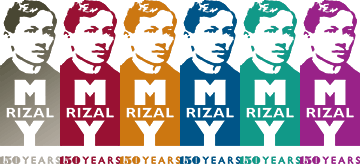
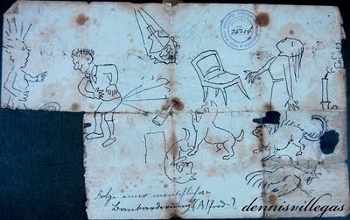
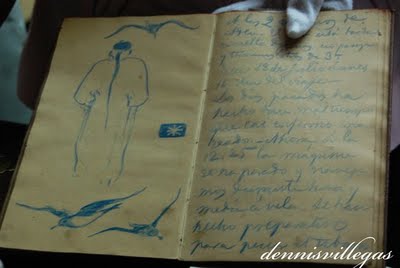
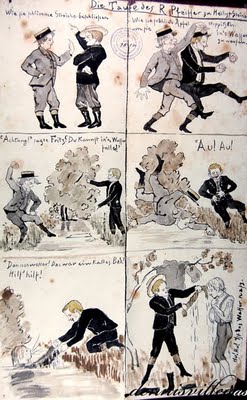
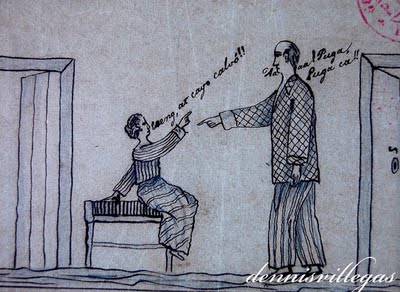
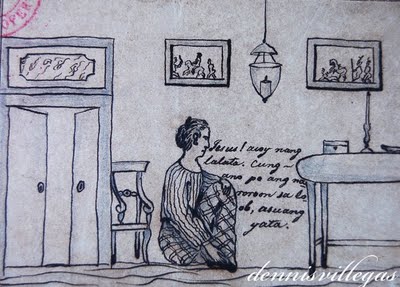
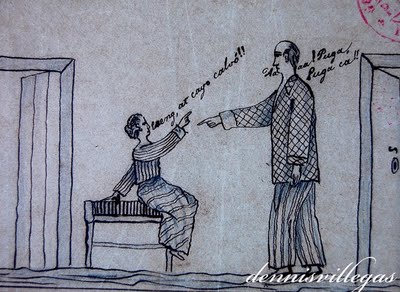
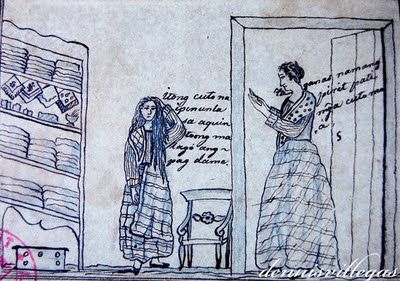
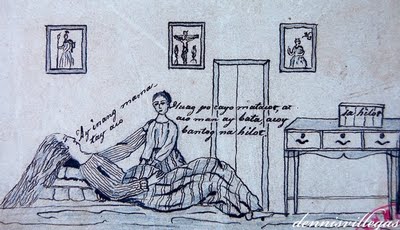
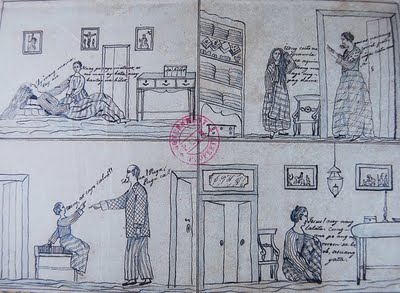
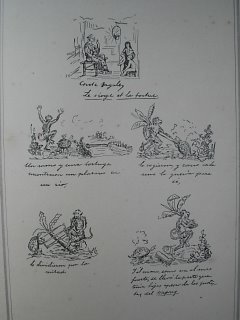
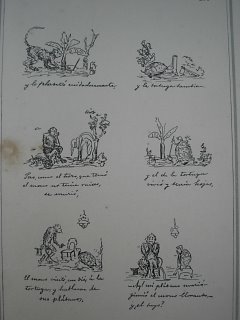
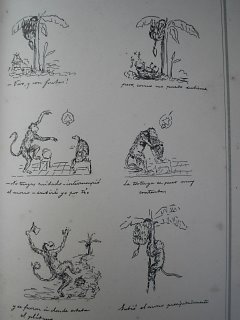
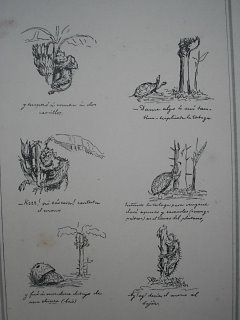
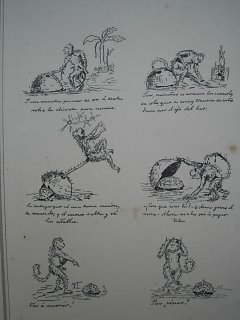

Pingback: NCBD + PBBY 2011 «